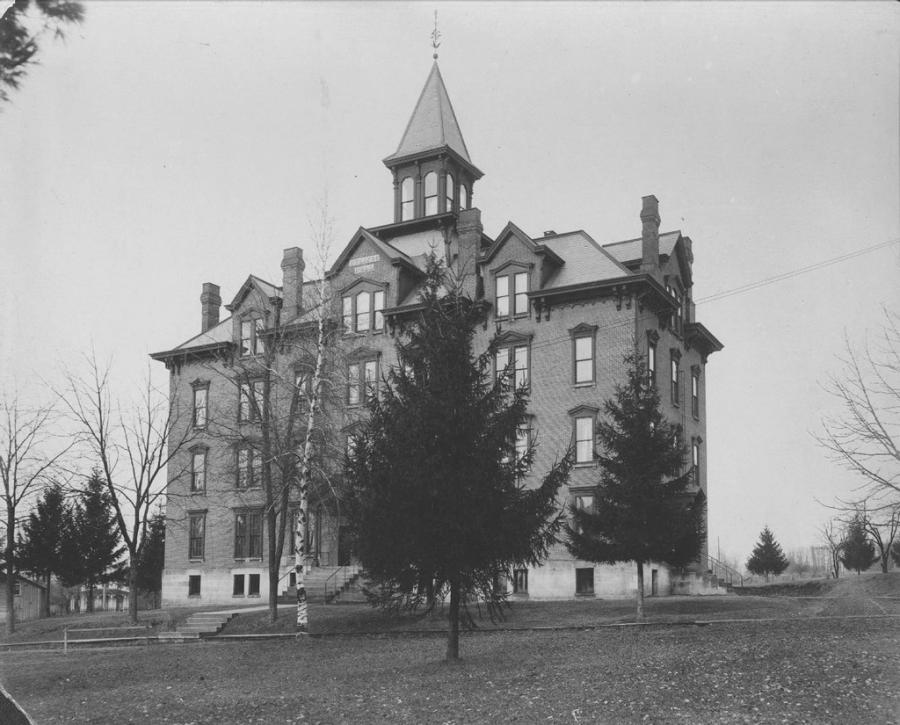The Allegheny Penny Dreadfuls
Campus ghost stories
Via: Merrick Archives Digital Images Collection Hulings Hall, as seen here in 1881, was constructed in 1871 as the first residence hall for women on campus.
Between the old buildings and even older traditions, Allegheny’s long history has generated its fair share of myths and legends. There are the classics — the likes of William McKinley’s infamous cow prank and the 13th plank of the Rustic Bridge. Beyond those relatively tame brochure-material stories, however, there lies a unique oral tradition of ghost stories.
From a bereaved lover lingering in Hulings to haunted sorority suites in Brooks, Allegheny has plenty of ghost stories — all of which are recorded in “The Painted Door: A Collection of the Ghost Stories of Allegheny College” by Todd Scott, ’98. While there is almost no evidence to prove these tales true — a fact that “The Painted Door” acknowledges — generations of Alleghenians have passed down the same stories throughout time, creating a miniature folk tradition within the college.
The building with the most ghost stories swirling around it is, without question, the Brooks complex: Hulings, Brooks, Walker and Walker Annex. The most famous of these stories revolves around Sarah, a female student who allegedly committed suicide after her boyfriend fell to his death from the Brooks balcony during their pinning ceremony. A pinning ceremony is a tradition in which a fraternity brother completes a task unique to his school — in this case, climbing the Brooks balcony — and pins his fraternity pin on his girlfriend as a signal of his commitment and intent to marry her.
As the story is told in “The Painted Door,” “On the night of Sarah’s pinning, her young lover … slipped during his climb up the face of the building and fell to his death in front of a great many spectators.” While others rushed to save her boyfriend, Sarah stood helpless on the balcony, looking down on the whole affair.
After a few weeks, Sarah allegedly committed suicide by hanging herself in the window of her third-floor room in Hulings Hall. The popular version of the story indicates that Sarah hoped to be reunited with her dead boyfriend in the afterlife.
Throughout the years, reports of the name “Sarah” written in the frost on the outside of the third-floor window and the apparition of a hanging body in the window have cropped up amongst Hulings residents. Other residents have experienced tampering with electronic devices.
“The Painted Door” claims that priests and members of campus ministry have attempted in the past to cleanse the third-floor room of the restless spirit. In one instance, all of the resident’s posters fell to the ground at the same time during a blessing. The posters met the ground with the sound of the shattering of glass, despite no glass in the room actually being broken. “The Painted Door” goes on to speculate that this was, perhaps, the spirit of Sarah reliving her death through the window.
As “The Painted Door” notes, “The timing of these tragic events is something that remains a mystery, and the skeptic has to wonder if the story was simply fabricated to support the haunting that occurs in the room.”
Despite the shaky backstory, the reports of the third-floor haunting have been repeated throughout the years and corroborated by many residents of Hulings Hall.

Mo is a sophomore from Columbus, Ohio. He is majoring in English and possibly minoring in JPI and/or Political Science. He is the Features Editor and this...

Sydney Emerson is a member of the class of 2023. She is from Bradford, Pennsylvania and is an English major with a history minor.







